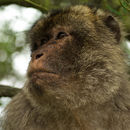Biology
provided by Arkive
Barbary macaques have a diet of fruit, young leaves, bark, roots and occasionally invertebrates. During the winter when food is scarce they forage for bark and evergreen needles (4). As social animals they live in troops of 12 to 60 (average approximately 24) individuals with females forming the core of the troop. Where there is abundant food and little human interference the home range sizes are smaller (2). Males will establish a hierarchy based on the outcome of competitive interactions, though ranking orders change regularly as males age, leave or enter the troop. The strongest and most successful males become dominant and generally do most of the mating, although all males in the troop may potentially mate with females (5). Reproduction may be somewhat seasonal, with births corresponding to highly productive seasons. Females give birth to a single offspring every one or two years, after a gestation of about five months, and twins are rare. The young are weaned after 12 months, and reach sexual maturity at 2.5 and 4 years old in females and 4.5 and 7 years old in males (5).
The mating system of this species is fascinating. Females mate with all male members of the troop, so males can never be sure of paternity (4). This promiscuous behaviour encourages males to look after one, or some of the young troop members, spending time grooming, protecting and playing with them, despite not knowing if they are their offspring (5). This may seem like an unselfish act, protecting another macaque's offspring, but because all males in the troop do the same, it is the only way the males can ensure that their offspring will survive. Young females remain within their natal group once they attain sexual maturity, whereas males disperse from their natal group. Becoming accepted into another group is, therefore, critical in the reproductive success of any individual male (5).
Conservation
provided by Arkive
Seen as a symbol of Gibraltar and valued as a tourist attraction, these macaques are protected to some extent (4). In Algeria, this species is protected in several national parks, but there are few active conservation policies elsewhere. There have been proposals to re-introduce them to the Kouf National Park in Libya, and also to re-introduce them to Tunisia (9). The World Conservation Union recommends further population studies of the Barbary macaque, and also the investigation of the bark-stripping problem in Morocco. National park protection must also be implemented more effectively (9).
Description
provided by Arkive
This species' alternative names, the Barbary ape or rock ape are misleading; for though it lacks a tail, as do apes, it is in fact a macaque, belonging to the old world monkeys (4). A large monkey with a silky grey to brown or yellow coat and a dark pink face. Males are somewhat larger than females, though in appearance they are very similar. Like all macaques, they have powerful jaws, long canine teeth, and cheek pouches beside the lower teeth that extend down the sides of the neck (5). These pouches are used to store food when foraging and are able to hold a volume of food as large as the stomach (5).
Habitat
provided by Arkive
In North Africa, this macaque inhabits oak and cedar forests, preferring mid and high altitude forests as well as scrub forest and cliff habitats. The climate is hot and dry in the summer and cold and snowy in the summer (5).
Range
provided by Arkive
This species is found in Algeria, Morocco, and Gibraltar (1). It is the only primate, apart from humans, to live in Europe and the only macaque to live outside of Asia (6) (7). Legend has it that as long as Barbary macaques exist in Gibraltar, the region will remain under British rule. Thus, following an epidemic in the 1900s wiping out the macaque population, local authorities re-introduced them from the African mainland and now protect a small population of about 160 individuals (5).
Status
provided by Arkive
Classified as Vulnerable (VU) on the IUCN Red List 2007 (1), and listed on Appendix II on CITES (3).
Threats
provided by Arkive
This species is threatened by habitat loss from logging and human settlements, as well as hunting (8). In Algeria forest fires and livestock grazing are additional problems, and some young animals are captured as pets. In Morocco the problems of logging and overgrazing are exacerbated by drought. Moroccan forestry authorities have considered culling macaques because of their bark stripping. They were once found throughout North Africa but now only exist in small areas (9).

